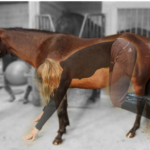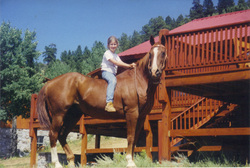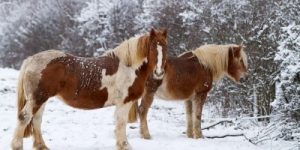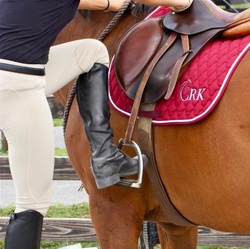As humans, we look different than our horses. Obviously. We walk on two feet, they stand on four hooves. They have long necks and big heads, we have short necks, and well, still rather big heads.
But if you look at our most basic anatomy, our skeletons, we are surprisingly similar to our horses.
Besides understanding how we need to move to be stable and balanced, When we recognize how similar our anatomy is to our horse, we see that our riding position directly impacts the position of the horse. If our back is hollow, our horse is hollow. If we inadvertently lean left, our horse will likely drift left.
If we tighten somewhere, the horse will often tighten in a corresponding part of their body.
In this video, I highlight a few areas of corresponding anatomy between horse and person – they may surprise you!
Click play to watch the video below!
Want to learn more about anatomy? Sign up for updates on the course with Wendy Murdoch: www.effortlessridercourse.com
Want the app I referenced in the video? https://itunes.apple.com/us/app/horse-anatomy-equine-3d/id542541355?mt=8














20 Responses
Thank you for your passion, effort and talent, Callie. I have watched a few of your videos during the past couple of years and am enjoying your evolving skills. At some point this summer, I plan to be in your region and would appreciate sharing some perceptions and discoveries with you if our schedules could align. The past 20 years of my life has been devoted to researching how possible it would be to provide saddle equipment allowing horses to move comfortably while carrying riders… with efficient biomechanics close to what they can enjoy while traveling naked. For horses ridden casually or in collection, we have developed tools and methodology to enhance (not detract from) the relationship with their humans while building proper muscle, balance and physique, not tearing it down. I shall leave contact info below and would love to meet Wendy, as well. Perhaps we could develop a meaningful association. Looking forward to hearing from you. Thanks for helping humans understand horses!
Hi Letitia, the best place to contact in regards to this would be our email, crktrainingvideos@gmail.com!
– Julia Burdy, CRK Training Community Manager
I was surprised to find out that the horse’s knee actually corresponds to our wrist and that they are, essentially, standing on their middle fingers. Same with the hock corresponding to our calcaneus bone (the heel). I’m a yoga teacher, and we sometimes talk about “spidering” the fingers to engage them when on all fours, so, in a small way, that is similar to what horses do all the time. Knowing what they are balancing on when they stand gives me some food for thought about how they move.
Thank you for sharing!
Joanna, very similar! Actually I was just recently discussing with a farrier about how with the horses’ hooves you want them to be weight bearing on four parts of the foot to support their weight efficiently.
– Julia Burdy, CRK Training Community Manager
Thank you. Very good information. Always enjoy your videos, they are very helpful
Most surprising to me was learning that the entire lower legs correspond to our hands and feet.
When horses’ Hocks are compromised is that like a human ankle?
Hi Ellen! When the horse’s hocks are compromised it makes it more difficult for them to step underneath of themselves and lift their back in an effective way – it does effect their movement and it does in people with ankle problems. Also when the joint isn’t moving as it was intended to the muscles develop in a different way, the horse may have more difficulty bending a particular direction because that leg doesn’t come up underneath of the belly to support the back and ribcage. I hope that helps answer your question
-Julia Burdy, CRK Training Community Manager
Thank you very much! It does help !
Ellen
I was surprised at the correlation between the 2 skeletons. I’d never thought about the similarities.
Learning that our knee and the horse’s stifle we’re correlated blew me away! The way I’ve always thought about horses legs has been totally wrong. This was a really fun lesson. Thank you!
I have always wanted to know more about horse Anatomy so this was a fascinating video for me! I totally did not realize how the horse’s anatomy was related to our human anatomy. Great information! One question – when we use our wrists for example while riding our horse does the horse’s knee somehow engage with our wrist?
Often times we do see a rider’s stiffness reflected in the movement of the horse, if we are tense or locked in a joint that doesn’t allow the movement and shock absorption needed to allow the horse to properly carry our weight and have free forward movement.
-Julia Burdy, CRK Training Community Manager
I was surprised that the human body was related to the horse body in general.
Thank you for that video and the tip on the horse anatomy app!
Glad you enjoyed this video Jeannette, they are more alike than I think most people think!
– Julia Burdy, CRK Training Community Manager
Most surprising was the thought of a thousand pounds being held up by such a small area like our middle finger!!
Right?! So amazing and it truly helps with visualizing how the horse has evolved
-Julia Burdy, CRK Training Community Manager
Dear Callie, thanks a lot for the geat video! For one of the up coming videos I would like to make a wish about a subject..could You tell a little bit about lounging problems and how You solve them? I like the old lounging video of Yours (I always lay my lounge this way in my hand now )Maybe You can give some advice for horses who are a little difficult, for example when they don´t like to work with You. A little tipp or trick to motivate
)Maybe You can give some advice for horses who are a little difficult, for example when they don´t like to work with You. A little tipp or trick to motivate  Have a nice day and many greeting from Cologne, Sophia, PS: Another really funny and amazing thing about anatomy You´ll see when You look up a picture of the foot-bones of an elefant
Have a nice day and many greeting from Cologne, Sophia, PS: Another really funny and amazing thing about anatomy You´ll see when You look up a picture of the foot-bones of an elefant  (comparing to human)
(comparing to human)
Sophia, thanks for the great suggestion! If you are following CRK Training on Facebook we actually just did a live stream where Callie talked a bit about issues with lunging and how to work through them. We will have to look up the elephant and human comparison too
-Julia Burdy, CRK Training Community Manager
Ditto to Constance “Most surprising to me was learning that the entire lower legs correspond to our hands and feet.” makes sense why the lower limbs are so sensitive!